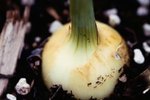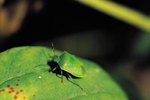
Insect eggs come in different shapes, sizes and colors depending on the species. Some are bullet shaped, some are keg shaped and some are gelatinous. Colors vary from black to white and everything in between. If you've found yellow eggs in your yard, the type of plant they're on or near may help you determine what insect laid them.
Moth Pests
Several moths have yellow eggs, and many of these species are pests of either agricultural crops or vegetable gardens -- or both. The corn earworm, also known as the tomato fruitworm, prefers to lay her yellow eggs on fresh corn silk, but will accept tomato foliage in the absence of corn silk. Pickleworms prefer cucurbits and will bore into the fruit. Adult moths lay the small, yellow eggs singly or in small clusters. Tomato pinworms, as their name suggests, prefer tomatoes and closely related plants such as eggplant and potato. Females lay eggs singly or in groups of two or three on the undersides of leaves.
Beetle Pests
Several species of blister beetle feed on vegetables, but prefer potatoes and tomatoes in certain regions. These slender beetles are often black or gray with narrow, gray or yellow stripes. Females lay clusters of 100 or more yellow eggs in the soil. The Colorado potato beetle prefers potatoes, but will feed on closely related plants such as tomatoes and eggplants. Females may produce more than 500 eggs during her short life, laying clusters of 20 or so on the undersides of leaves. Striped cucumber beetles are pests throughout their life: Adults feed on leaves, stems and fruit of host plants while their larvae feed on roots and the underground plant parts. Squash beetles also lay clusters of 30 to 50 yellow eggs.
Beneficial Predators
Not all insects in the garden are pests, and not all yellow eggs are from pest insects, either. Nearly every species of lady beetle in North America is a beneficial predator of pests including aphids. These spherical predators lay eggs masses of bright yellow, oval eggs on the surfaces of leaves. Lacewings also are beneficial predators, feeding on aphids, mites, thrips, eggs and soft-bodied pests. Unlike other insects, the female deposits her eggs singly on strands of silk that harden into stalks. The bright yellow, yellowish-green or pale green eggs appear to be suspended in midair under the stems or leaves from which they hang.
About Eggs
Insects lay their eggs on or near their larval food source. Vegetable pests, for example, lay eggs on the leaves of the plants they eat. Predators, on the other hand, lay eggs near pest populations. Egg laying often takes place during the warmer months, although some insects lay eggs in the fall. Throughout the summer, a close examination of vegetable leaves, ornamental plants or wildflowers may turn up innumerable insect legs.
References
- North Carolina Agricultural Extension Service: Insect pests of Vegetables
- Clemson Cooperative Extension: Cucumber, Squash, Melon & Other Cucurbit Insects
- University of Florida IFAS Extension: Insect Management for Tomatoes, Peppers and Eggplant
- Purdue Extension: Vegetable Insects: Squash Beetle on Cucurbits
- University of Kentucky Entomology: Ladybugs
- University of Nebraska-Lincoln: Beneficial Arthropods of Woody and Herbaceous Perennials
- Virginia Tech: The Mid-Atlantic Fruit Loop: Lacewings
Photo Credits
-
Ablestock.com/AbleStock.com/Getty Images
Writer Bio
With a professional background in gardening, landscapes, pests and natural ecosystems, Jasey Kelly has been sharing her knowledge through writing since 2009 and has served as an expert writer in these fields. Kelly's background also includes childcare, and animal rescue and care.




